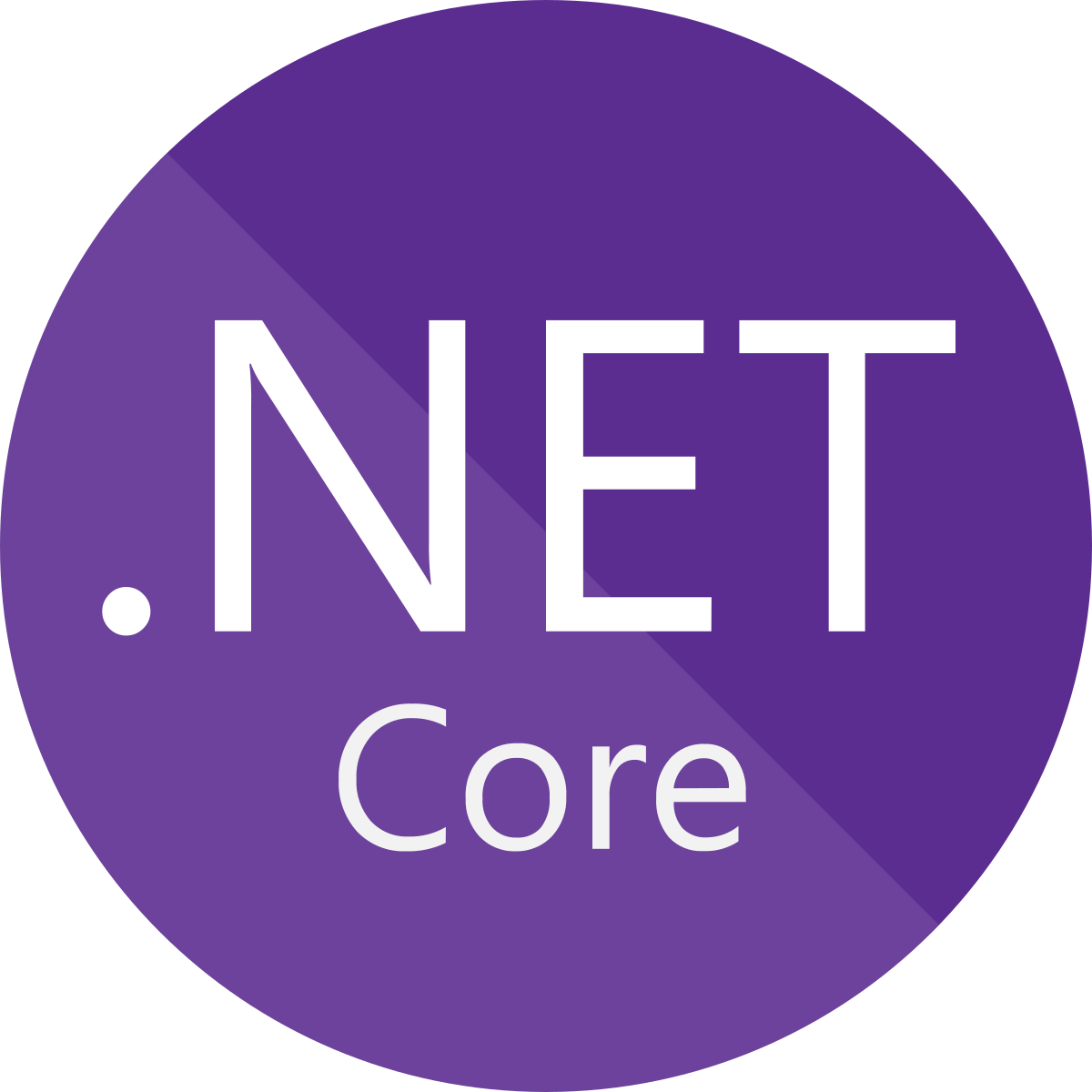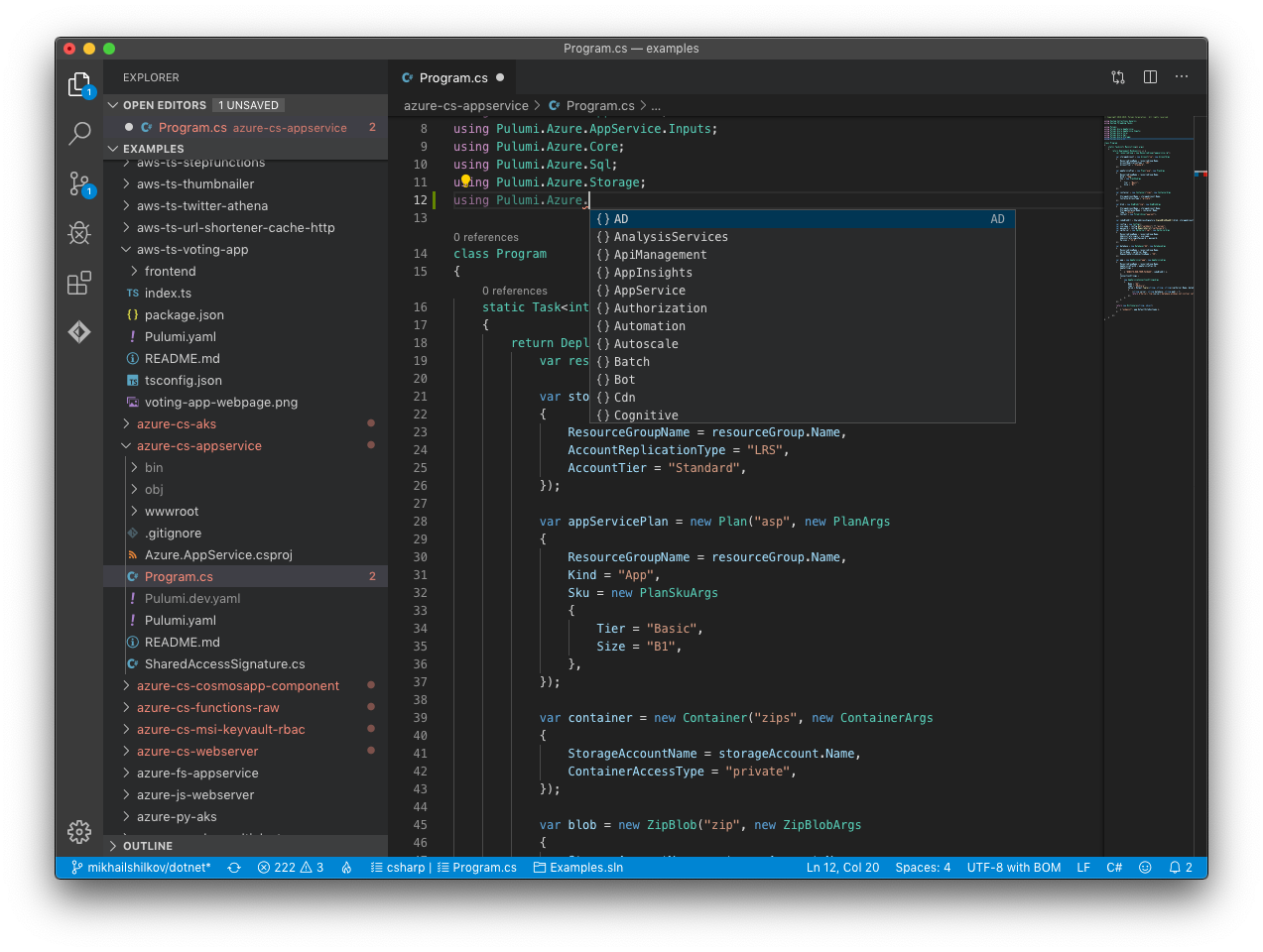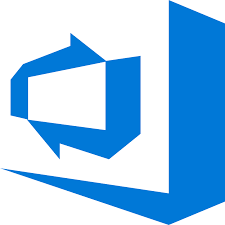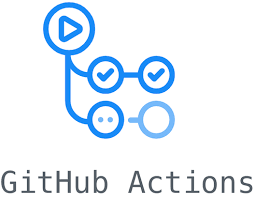Pulumi & C#, VB, F# (.NET)

Pulumi supports writing your infrastructure as code in any .NET language programs running on dotnet using any supported version.
You can use your favorite .NET tools — such as editors, package managers, build systems, and test frameworks — to create, deploy, and manage infrastructure on any cloud, including Azure, AWS, and Google Cloud.
Prerequisites
Before using Pulumi for .NET, you will need to install both Pulumi and a supported .NET version.
Example
For example, this C# program provisions an Azure resource group and storage account:
using System.Threading.Tasks;
using Pulumi;
using Pulumi.Azure.Core;
using Pulumi.Azure.Storage;
class Program
{
static Task<int> Main() => Deployment.RunAsync<MyStack>();
}
public class MyStack : Stack
{
public MyStack()
{
// Create an Azure Resource Group
var resourceGroup = new ResourceGroup("resourceGroup", new ResourceGroupArgs
{
Location = "West Europe",
});
// Create an Azure Storage Account
var storageAccount = new Account("storage", new AccountArgs
{
ResourceGroupName = resourceGroup.Name,
AccountReplicationType = "LRS",
AccountTier = "Standard",
});
// Export the connection string for the storage account
this.ConnectionString = storageAccount.PrimaryConnectionString;
}
[Output] public Output<string> ConnectionString { get; set; }
}
For example, this F# program provisions an Azure resource group and storage account:
module Program
open Pulumi.FSharp
open Pulumi.Azure.Core
open Pulumi.Azure.Storage
let infra () =
// Create an Azure Resource Group
let resourceGroup = new ResourceGroup "resourceGroup"
// Create an Azure Storage Account
let storageAccount =
new Account("storage",
new AccountArgs
(ResourceGroupName = io resourceGroup.Name,
AccountReplicationType = input "LRS",
AccountTier = input "Standard"))
// Export the connection string for the storage account
dict [("connectionString", storageAccount.PrimaryConnectionString :> obj)]
[<EntryPoint>]
let main _ =
Deployment.run infra
For example, this Visual Basic program provisions an Azure resource group and storage account:
Imports System.Threading.Tasks
Imports Pulumi
Imports Pulumi.Azure.Core
Imports Pulumi.Azure.Storage
Module Program
Public Function Run() As IDictionary(Of String, Object)
' Create an Azure Resource Group
Dim resourceGroup = New ResourceGroup("resourceGroup")
' Create an Azure Storage Account
Dim storageAccount = New Account("storageAccount", New AccountArgs With {
.ResourceGroupName = resourceGroup.Name,
.AccountReplicationType = "LRS",
.AccountTier = "Standard"
})
' Export the connection string for the storage account
Return New Dictionary(Of String, Object) From {
{"connectionString", storageAccount.PrimaryConnectionString}
}
End Function
Sub Main()
Deployment.RunAsync(AddressOf Run).Wait()
End Sub
End Module
C#, F#, and VB Templates
You can write Pulumi programs in your favorite .NET language to get additional verification and tooling benefits. The fastest way to get started is to use a template. The template will autogenerate a set of files and initialize a Pulumi project.
You can write Pulumi programs in C#. From an empty directory, create a new C# project:
$ mkdir myproject && cd myproject
$ pulumi new csharp
This will create a Pulumi.yaml project file containing some minimal metadata about your project (including a name and description which you may wish to change), an myproject.csproj file that holds references used by the project, a Program.cs file, containing the program entry point and resource definitions. The name of the directory is used as the project name in Pulumi.yaml and as the csproj file name.
To deploy your infrastructure run pulumi up and the Pulumi engine automatically runs dotnet build as part of the deployment. Pulumi will perform the operations needed to deploy the infrastructure you have declared.
This csharp template is cloud agnostic, and you will need to install NuGet packages for the cloud provider of your choice. Additional templates are available:
pulumi new aws-csharp: creates a starter AWS C# projectpulumi new azure-csharp: creates a starter Azure C# projectpulumi new gcp-csharp: creates a starter Google Cloud C# project
You can write Pulumi programs in F#. From an empty directory, create a new F# project:
$ mkdir myproject && cd myproject
$ pulumi new fsharp
This will create a Pulumi.yaml project file containing some minimal metadata about your project (including a name and description which you may wish to change), an myproject.fsproj file that holds references used by the project, and a Program.fs file, containing your program. The name of the directory is used as the project name in Pulumi.yaml and as the fsproj file name.
To deploy your infrastructure run pulumi up and the Pulumi engine automatically runs dotnet build as part of the deployment. Pulumi will perform the operations needed to deploy the infrastructure you have declared.
This fsharp template is cloud agnostic, and you will need to install NuGet packages for the cloud provider of your choice. Additional templates are available:
pulumi new aws-fsharp: creates a starter AWS F# projectpulumi new azure-fsharp: creates a starter Azure F# projectpulumi new gcp-fsharp: creates a starter Google Cloud F# project
You can write Pulumi programs in Visual Basic. From an empty directory, create a new Visual Basic project:
$ mkdir myproject && cd myproject
$ pulumi new visualbasic
This will create a Pulumi.yaml project file containing some minimal metadata about your project (including a name and description which you may wish to change), an myproject.vbproj file that holds references used by the project, a Program.vb file, containing the program entry point and resource definitions. The name of the directory is used as the project name in Pulumi.yaml and as the vbproj file name.
To deploy your infrastructure run pulumi up and the Pulumi engine automatically runs dotnet build as part of the deployment. Pulumi will perform the operations needed to deploy the infrastructure you have declared.
This visualbasic template is cloud agnostic, and you will need to install NuGet packages for the cloud provider of your choice. Additional templates are available:
pulumi new aws-visualbasic: creates a starter AWS Visual Basic projectpulumi new azure-visualbasic: creates a starter Azure Visual Basic projectpulumi new gcp-visualbasic: creates a starter Google Cloud Visual Basic project
.NET Tools
Pulumi packages are distributed on NuGet for download.
Although you can use any editor, Visual Studio Code, Visual Studio, or Rider will deliver full tooling support for .NET out-of-the-box, including auto-completion, red error markers and build errors.

Pulumi Programming Model
The Pulumi programming model defines the core concepts you will use when creating infrastructure as code programs using Pulumi. Concepts describes these concepts with examples available in Python. These concepts are made available to you in the Pulumi SDK.
The Pulumi SDK is available to .NET developers as a Nuget package. To learn more, refer to the Pulumi SDK Reference Guide.
The Pulumi programming model includes a core concept of Input and Output values, which are used to track how outputs of one resource flow in as inputs to another resource. This concept is important to understand when getting started with .NET and Pulumi, and the Inputs and Outputs documentation is recommended to get a feel for how to work with this core part of Pulumi in common cases.
Continuous Delivery
In addition to the CLI-driven workflows shown above, you can continuously deploy your infrastructure using .NET by integrating with your CI/CD provider of choice. This ensures automated deployments triggered by events such as commits to your Git repo.
Azure DevOps Pipelines

Pulumi can deploy infrastructure changes from your Azure DevOps Pipelines. This enables easy integration with your existing automation while using .NET for your infrastructure as code, leveraging the Pulumi task in the Visual Studio Marketplace.
To learn more, see the Pulumi Azure DevOps user guide.
GitHub Actions

Pulumi can deploy infrastructure using GitHub Actions, making Git-driven deployments of your infrastructure as code straightforward. To learn more, see the Pulumi GitHub Actions user guide.
There is also a Pulumi GitHub App that integrates with Pull Requests so that you get previews of deployments before they are merged inline in your PRs where it’s easy to comment and collaborate.
Other CI/CD Integrations
If you don’t use Azure DevOps or GitHub Actions, Pulumi also supports a number of other CI/CD integrations.
Package Documentation
SDK reference documentation, organized by language.
Dev Versions
Pulumi SDKs also publish pre-release versions, that include all the latest changes from the main development branch. To use them you can use the --prerelease flag. For example dotnet add package Pulumi --prerelease.
Standard Packages
In addition to the standard packages the Pulumi Registry houses 100+ .NET packages.
- Pulumi SDK
- Pulumi
- Pulumi FSharp SDK
- Pulumi.FSharp
- Pulumi Automation API
- Pulumi.Automation
Thank you for your feedback!
If you have a question about how to use Pulumi, reach out in Community Slack.
Open an issue on GitHub to report a problem or suggest an improvement.
